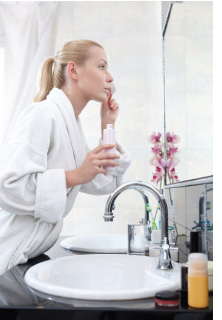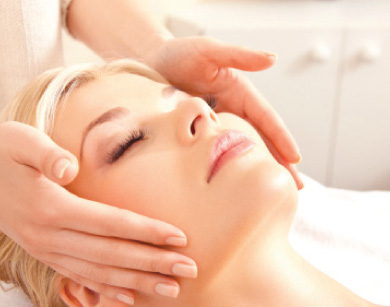Three Core Truths About Skin and Time:
1.Your clients are obsessed with not looking their age.
2.They want immediate results from any service/product.
3.Your clients are time-obsessed and time-deprived, and this reality deeply affects their attitude, skin care experience
and self-care.
A defining fact of modern culture is that people in the industrial world perceive time very differently than prior generations did. With the acceleration of technology, it is a fact of modern life that we tend to feel life moving faster and faster. And this contributes to our obsession with age and aging! We can literally feel ourselves getting older by the second, and it no longer seems like a gradual process.
It is undeniable that the digital revolution of the 1980s allowed world news to travel faster than our grandparents could literally ever have dreamed. For example, news of an earthquake in the South Pacific or in Asia would have taken weeks, months or more to reach people in Europe or the United States; today, we know within seconds. In fact, we can observe events as they happen, thanks to the video feature of the cell phone and the array of other personal electronics.
Because we literally know about so much more happening in real time in the world around us, the minutes fly past. The long silences and the rhythm of natural, organic life – seasons and cycles – which shaped the pre-technology world are now cluttered and noisy with unrelenting pings, posts, tweets, messages and other forms of constant, if impersonal, interaction.
This global acceleration makes us impatient and makes waiting impossible. This contemporary cultural meme has a tremendous impact upon how we as skin care professionals do our work, and it is why hucksters on late-night television promise "overnight results" from a gel, a capsule, an exercise contraption or a special diet. According to the Huffington Post, some sources state that the United States market for cosmeceuticals alone approached $20 billion per year. Many of these products would be termed "quick fixes." As professionals, we know that skin health, like all wellness, requires a lifelong practice and commitment, a partnership between client and therapist.
But your clients do not want to hear it – they are too "crazy-busy" for that kind of long-term approach.
Start with the Realization that Your Clients do not Have Time for Skin Care.
How is this for irony: many social anthropologists and cultural studies reveal that people in the industrialized world actually have less – not more – leisure time than our grandparents and prior generations. In spite of the fact that we tend to discuss leisure as a modern invention, the truth is that prior to industrialization, people worked largely in submission to the whims of nature. Early dark or a month of rain brought farmers in from the fields, for instance. Not until artificial lighting did people begin working late into the night. Not until central heat and air conditioning did people begin working year-round. Today, because we have the technological capacity to work and play around the clock, there is less true down-time and rest than ever before – and we are quite naturally exhausted!
This means that your clients are time-pressed. This is especially true of women, who are statistically proven to carry more of the domestic burden than men in most United States households. Women are busy! We work outside the home and we still wipe those little crusty noses, water the plants, and wash the socks far more than our male counterparts.
What does this mean to you as a skin professional? That your client is more likely than ever to be late for her skin care appointment, to book shorter treatments, less frequent treatments, to delay her appointments, and to simply not show.
The long, languid "spa days" – if they ever really existed at all – now are most definitely a thing of the past. Every minute counts, more than ever.
To get just a micro-picture of the issue, The International Dermal Institute has uncovered this alarming fact: women in America spend less than one minute each day cleansing their faces. I find this shocking, but women are in a hurry when it comes to washing their faces! This means that the super-resistant, long-wearing makeup and sun-care formulas we love so much leave a residue because we do not wash thoroughly. That residue collects in the folds of the eye and at the hairline, causing irritation, milia and other issues. Just an example of what traditional Japanese culture calls "hurry-sickness." It once was specific to the West, but now it is gone global. (Quick tip: for the client who may not take time to cleanse deeply, recommend an oil-based pre-cleanse product to remove long-lasting cosmetics, especially eye and lip pencil, and also recommend the double-cleanse, for truly clean skin.)
 Add to This that They do not Believe in the Idea of Growing Old Gracefully.
Add to This that They do not Believe in the Idea of Growing Old Gracefully.
Kicking and screaming is more like it. The reasons are vast and far-reaching, including the huge fact that women in our society tend to marry later in life than was the case in past generations. And add divorce to the equation. Not to sound cynical, but a first-time bride in her mid-thirties may find herself on the market again at 50 – all of which equates to a woman who will not embrace white hair, laugh lines, spots on the backs of her hands, or a silhouette which shows the natural effects of collagen-loss, elastin-loss and gravity as readily as her grandmother may have.
What to Do?
Communicate to the client that partnership is needed to age "smart." It takes two, baby. While the professional therapist provides the expertise, there must be an attitude of participation coming from the client. Otherwise, she is asking you to be a magician. Not even cosmetic surgeons work alone: even a facelift requires partnership, based upon communication.
Skin analysis is a tool for the professional skin therapist to create a structured, skin-based conversation with a client, involving them through the process. Skin analysis gives the therapist a vocabulary to identify and confirm the client's concerns, recommend the correct professional treatment, and effectively prescribe a home care routine. With an effective skin analysis, you can build a lasting relationship based on trust and commitment.
In a professional treatment, a skin analysis should be given after cleansing and prior to commencing the results-driven part of your professional
skin treatment.
Skin analysis is not just a closed-door exercise. This service can, and should, be performed on any clients that are looking to improve or maintain the health of their skin – especially valuable to those in a rush.
NFLB!
Make "No Face Left Behind" your new motto. To create exceptional treatments, prescribe results-driven home care products and present your expertise in the form excellent customer service (do not keep her waiting!).
When providing your clients with advice on their skin, it is important to remember to look for the root-cause of the problem. Treating the symptoms without addressing the source cannot give the results the client is looking for. In fact, in the context of time-management, not addressing the causal factors is what often results in ineffective treatments and leaves clients dissatisfied with your skills and products. I find that clients are more protective of their time than their money. Waste her time and you will never see her again.
To Save Time, Ask Key Questions Up Front
- Dietary Considerations: If she is trying to drop pounds, giving up gluten and dairy, or on a detoxification diet or a fast, know her skin may break out. If she is a vegetarian or vegan, and as a result has a low protein and fat intake, the skin may become very dry.
- Medications and medical procedures: Ask about prescriptions she is taking and any recent surgeries. To cut to the chase, cancer treatment is a huge aspect of skin care today. All drugs affect the skin, including antibiotics, steroids and chemotherapy drugs. Radiation also has profound effects upon the skin. Be gentle, but direct. Ask.
- Sinus conditions: Check the areas across the cheeks. Lung distress and sinus distress may result in red, inflamed, sensitized areas here.
- Moisture/Hydration: Lack of water and excessive alcohol consumption, sun exposure and lack of adequate protection will indicate the hydration levels your client's skin. Inflammation is a classic sign of dehydration, as well as multiple cocktails on a daily basis.
- Perception: Understanding the client's own perception is essential to the success of your long-term relationship. Ask the client what she expects and hopes to accomplish as the result of her skin care treatment, regardless of what your own professional opinion may be. Find out what her priorities are, again in the interest of time-management. For instance, in the anti-aging category, she may be more upset about her hyperpigmentation than her deep marionette lines or crepiness around the upper eye area. So be it – allow your client's primary priorities to guide your prescription
and treatment.
Skin Scene Investigation: SSI!
A skin analysis may almost be compared to doing a "crime scene investigation": you must observe, gather clues, review evidence and consider motivation. Some of what you perceive will be intuitive, and some of it based on hard facts. Do not be afraid to follow your gut-hunches during the
questioning process.
The Four Agreements of Professional Skin Care
Listen: When we have a new client in for a skin care treatment, we have to believe that they are making the time and making the effort for good reason. Unless it is just a random Gift Certificate, the new client is most likely highly motivated. Most people are crying out for the correct advice on their skin. A recent survey suggests that out of 100 people who went for first time treatment, 80 percent wanted advice on their skin. But only a mere three percent reported that they got what they were after.
Think of all the potential prescription retailing that could come from that simple art of listening and really finding out what your client wants or needs. The art of listening is a skill. Give the client the opportunity to express what it is that she would most like to change about her skin, or any problem she may want to share.
Speak: Speaking can be a challenging aspect of the consultation for some therapists, especially if they are not sure what to ask. Remember that effective speaking first comes from effective listening.
There is no need to lecture or to come off as the world's biggest authority on comedones. The client places herself into your hands with trust. Honor that trust by honoring the whole person, not just the skin. Begin with compassion, with respect, and with listening. You do not need to be an aggressive salesperson or a human encyclopedia. Be receptive, be nurturing, and pay attention.
I recommend first getting an overall feel, visually, and with the fingertips (see next point). Take in general observations. Ask general questions. Listen for overall tone of voice (Tired? Stressed? Negative? Upbeat?) as you assess tone of skin and subtle messages like body posture, gesture and energy. Then begin to look at the skin in small zones. When you examine the skin, you want to touch and analyze one area at a time; share what you are seeing and feeling with the client. You can begin to problem-solve at this stage by suggesting products and ingredients and creating desire for your client. Do not go into in-depth product knowledge on a product as this will come across as selling, but offer a product solution to a skin problem (as in a spot treatment for stubborn breakouts).
Touch: Take gloves off. Touch the client as soon as you can. This is the start of your relationship and helps the client to feel comfortable. Touch an arm or shoulder to guide or shake their hand sincerely when saying hello. Touching the skin through analysis is essential, because only with your own skin will you detect the nuances of under-the-surface congestion, hormonally triggered hair growth, excess oiliness, sluggish energy, rapid pulse, etcetera. You will also detect tension, loss of elasticity, and excess heat or cold that may not be visible to the naked eye.
Look: From the minute the client walks through the door, check the total package – the skin is only part of it. Take an overall reading. First impressions are indeed lasting impressions, and in my opinion are generally valid. Personality type, general stress levels, color of skin, breakouts, amount of makeup, and body language are broadcast immediately by all of us. Reading these cues is a good place to start. Then, probe further with your high-tech tools – the magnifying lamp and Skin Scanner, among others.
I will say this: the skin itself is a low-tech tool, but it never lies. Listen to what your own skin tells you when you encounter a new client – or even greeting a returning client. Does she say that she is "…just fine" but yet her skin has a clammy texture, or feels flushed or hot? Respect her verbal report, but also stay tuned in on the vibrational or
energetic level.
 If in Doubt, Remember Your Four "R"s.
If in Doubt, Remember Your Four "R"s.
Recognize: Your first step is to recognize what you see on the skin during your consultation (I recommend writing it down on a consultation card). How do you know what is going on in the skin if you do not recognize it? Is it a skin condition, skin disease, or a skin type? Does she need a referral to an MD (for instance, evidence of cystic acne)? You have to recognize what you
are seeing!
Reason: Why are you seeing it? What is the reason she is there for a treatment? People do not wake up, look in a mirror, and think, "Wow, my skin looks great… I need a skin treatment!" Just the opposite. They come to you in distress, when they need help. Part of your job is to suss out her true reasons for coming to you. What is the reason for the concerns she has, and what is the reason behind the condition?
Reiterate: Talk to your client. You are not doing them a service if you are just hemming and hawing during the analysis. Talk to her! Reiterate what she has shared about her at-home routine, what products she uses, and any relevant details about lifestyle. Create adialogue with your clients. If you do not have this, you cannot retail ("retailing" should be the fifth R). Stand up in your own expertise! Own it and share it.
Recommend: This is pulling all the other elements into one. While we respect our clients immensely, they do not have our expertise. They come to us for expert guidance. Again, we do not want to be high-handed or authoritarian; but at the end of the day, the client often comes to you because she cannot figure it out on her own. She may have tried an array of drugstore and department stores brands and not gotten the results she wants.
In short, she wants your help. She wants your expert recommendations, as long as you frame and ground your advice and prescriptions in a rational, approachable way.
Complete skin care is not a DIY proposition within the health and wellness equation. A great deal of what makes professional skin care valid is the personal, skin-on-skin interaction – never underestimate the power of your touch, in addition to your
technical learning.
Your client needs your expertise and wants your guidance. Today, she is bombarded with media messages and misleading misinformation. If she has a recurring skin issue, or especially if she is doing her best to push back again the inevitable effects of aging, she may feel overwhelmed by the shrill onslaught of marketing pitches, promises, claims and pseudo-science which promise firmness, smoothness, moistness, clarity, contour and more, but simply do not deliver. Without your skills, compassionate hands, and professional assistance, she is just wasting her time.
 Heather Hickman is a fully qualified skin, spa and body care specialist from London, England. She is CIDESCO and IHBC qualified. Hickman has 20 years of experience in the skin care and spa industry as a spa manager and senior educator. She has taught extensively throughout the United States, United Kingdom, Europe and Asia, specializing in advanced skin care modalities and techniques. In her current position as Director of UNITED STATES Education for The International Dermal Institute and Dermalogica at the Corporate Headquarters in Los Angeles, Hickman is responsible for overseeing UNITED STATES brand operations, curriculum development, marketing activities and Education Teams for all 18 International Dermal Institute Training Centers.
Heather Hickman is a fully qualified skin, spa and body care specialist from London, England. She is CIDESCO and IHBC qualified. Hickman has 20 years of experience in the skin care and spa industry as a spa manager and senior educator. She has taught extensively throughout the United States, United Kingdom, Europe and Asia, specializing in advanced skin care modalities and techniques. In her current position as Director of UNITED STATES Education for The International Dermal Institute and Dermalogica at the Corporate Headquarters in Los Angeles, Hickman is responsible for overseeing UNITED STATES brand operations, curriculum development, marketing activities and Education Teams for all 18 International Dermal Institute Training Centers.
Want to read more?
Subscribe to one of our monthly plans to continue reading this article.